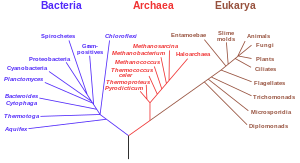Domain (biology)

In biological taxonomy, a domain (/dəˈmeɪn/ or /doʊˈmeɪn/) (Latin: regio[1]), also dominion,[2] superkingdom, realm, or empire, is the highest taxonomic rank of all organisms taken together. It was introduced in the three-domain system of taxonomy devised by Carl Woese, Otto Kandler and Mark Wheelis in 1990.[1]
According to the domain system, the
Non-cellular life, most notably the viruses, is not included in this system. Alternatives to the three-domain system include the earlier two-empire system (with the empires Prokaryota and Eukaryota), and the eocyte hypothesis (with two domains of Bacteria and Archaea, with Eukarya included as a branch of Archaea).
Terminology
The term domain was proposed by Carl Woese, Otto Kandler, and Mark Wheelis (1990) in a three-domain system. This term represents a synonym for the category of dominion (Lat. dominium), introduced by Moore in 1974.[2]
Development of the domain system
Carl Linnaeus made the classification of domain popular in the famous taxonomy system he created in the middle of the eighteenth century. This system was further improved by the studies of Charles Darwin later on but could not classify bacteria easily, as they have very few observable features to compare to the other domains.[5]
Carl Woese made a revolutionary breakthrough when, in 1977, he compared the
Characteristics of the three domains



Each of these three domains contains unique
Archaea
Archaea are prokaryotic cells, typically characterized by membrane lipids that are branched
Archaea evolved many cell sizes, but all are relatively small. Their size ranges from 0.1 μm to 15 μm diameter and up to 200 μm long. They are about the size of bacteria, or similar in size to the
Bacteria
There is a great deal of diversity in the domain Bacteria. That diversity is further confounded by exchange of genes between different bacterial lineages. The occurrence of duplicate genes between otherwise distantly-related bacteria makes it nearly impossible to distinguish bacterial species, count the bacterial species on the Earth, or organize them into a tree-like structure (unless the structure includes cross-connections between branches, making it a "network" instead of a "tree").[1]
Eukarya
Members of the domain Eukarya – called eukaryotes – have membrane-bound organelles (including a nucleus containing genetic material) and are represented by five
Exclusion of viruses and prions
The three-domain system includes no form of non-cellular life. Stefan Luketa proposed a five-dominion system in 2012, adding Prionobiota (acellular and without nucleic acid) and Virusobiota (acellular but with nucleic acid) to the traditional three domains.[9]
Alternative classifications
| Taxonomical root node | Two superdomains (controversial) | Two empires | Three domains | Five Dominiums[10] | Five kingdoms | Six kingdoms | Eocyte hypothesis |
|---|---|---|---|---|---|---|---|
| Biota / Vitae / Life | Acytota / Aphanobionta non-cellular life |
Virusobiota (Viruses, Viroids) | |||||
| Prionobiota (Prions) | |||||||
| Cytota cellular life
|
Prokaryota / Procarya (Monera) |
Bacteria | Bacteria | Monera | Eubacteria | Bacteria | |
| Archaea | Archaea | Archaebacteria | Archaea including eukaryotes | ||||
| Eukaryota / Eukarya | Protista | ||||||
| Fungi | |||||||
| Plantae | |||||||
| Animalia | |||||||
Alternative classifications of life include:
- The two-empire system or superdomain system, proposed by Mayr (1998), with top-level groupings of Prokaryota (or Monera) and Eukaryota.[11][12]
- The eocyte hypothesis, proposed by Lake et al. (1984),[13] which posits two domains: Bacteria and Archaea, with Eukaryota included as a subordinate clade branching from Archaea.[14][13][15]
See also
- Biological dark matter
- Neomura, which is the two domains of life of Archaea and Eukaryota
- Phylogenetics
- Protein structure
- Realm (virology), an equivalent rank for non-cellular life
- Systematics
References
- ^ PMID 2112744.
- ^ JSTOR 1218807.
- S2CID 244823103.
- PMID 32097647.
- ^ "Domains of Life, Genomics | Learn Science at Scitable". www.nature.com. Retrieved 1 December 2022.
- ^ "Taxonomy I | Biology". Visionlearning. Retrieved 1 December 2022.
- PMID 19073919.
- S2CID 1615592.
- ^ Luketa S. (2012). "New views on the megaclassification of life" (PDF). Protistology. 7 (4): 218–237. Archived from the original (PDF) on 2 April 2015. Retrieved 4 October 2016.
- ^ Luketa, Stefan (2012). "New views on the megaclassification of life" (PDF). Protistology. 7 (4): 218–237.
- PMID 9707542.
- PMID 15306349. Retrieved 29 April 2010.
- ^ PMID 6587394.
- PMID 19091952.
- S2CID 4461775.
External links
- Learn Biology: Classification-Domains on YouTube
